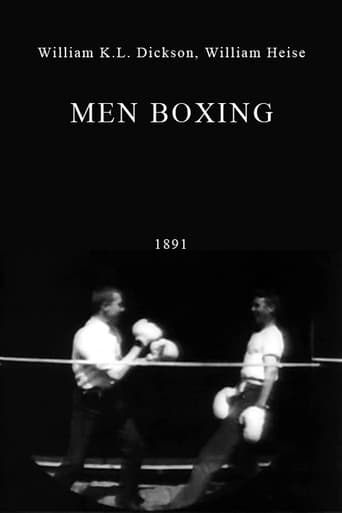cricket crockett
read the overwrought film notes for this short on disc 1 of the 4-disc set, THE INVENTION OF MOVIES, from Kino Co. (2005). The so-called expert contends that the "boxers" featured here are "disciplined, toned athletes," but to my eye these jokers in white shirts and dress pants obviously are "fleshy tinkers." All their punches are pulled, and they are grinning like jackals at the thought that ANYONE in the rough and tumble times of the 1890s COULD mistake them for "athletes." Since this was a camera test for Edison Manufacturing Company, it's clearly an "inside joke" met only for the girls in the New York City red-light districts where these guys spent their nights wilding (one look at this 12.13-second piece proves these guys were unlikely to have merited wives OR girlfriends!). Close observers will notice that this already brief film IS THE SAME THING SHOWN FOUR TIMES, but guys never can get enough of looking at themselves pretending to be sports heroes. Note that the rope behind the "boxers" meant to suggest a boxing ring is one of the first uses of art direction in the movies.
Bladerunner•
This hotly anticipated film fails to deliver. The special effects are spectacular, but the real action is lacking. The characters aren't defined at all, you simply don't identify with them in any way. The dialog has it moments to be sure, but subtitles just can't convey the idiosyncrasies of the human voice. The direction is pedestrian, at times I wondered if anyone was at the helm at all. It is a lengthy tome to be sure, but not overlong given the subject matter. The cinematography is rather good, and the decision to go monochromatic was a masterstroke. No sequels were planned or made, though many iterations have followed. This is not on the par with Rocky, and doesn't even come close to the sparkling, violent energy of Raging Bull, with which is shares a common theme (and common color - B&W). There is some very deep subliminal ideology, on several levels at work here. However, I think it will be many years before many of them are recognized and appreciated by the savvy filmgoer. All in all this is a masterpiece, even if the technical aspects, and certain performances lack the power of the subject matter and denouement.
addick-2
Perhaps the censors got to this one. For a title that offers the promise of nothing but blood splattering action this is a lame affair. Two men standing feet apart waving comical 'Mickey Mouse' white gloves at each other. I don't know if the guy on the right knew that he was becoming part of cinema history but I'm sure that he is disappointed that his five seconds of fame find him in a submissive 'come and get me big boy' stance.Still better than Rocky V though.
James M. Haugh
The Wizard of Menlo Park and the inventor of the electric light bulb, Thomas Alva Edison, moved his laboratory facilities (in late 1877) to a new location in West Orange, New Jersey. At about this same time he completed work on his invention of the phonograph. Beginning in 1878, Edison marketed the phonograph as an "entertainment novelty" and soon turned it into a popular consumer product.At this new facility, Edison started a lucrative project (he thought) to automatically extract the metal from iron ore during the milling process - he would loose his shirt on this project which never was successful.Encouraged by the work of others, particularly Eadward Muybridge (Muybridge had developed a method of taking pictures in quick succession, with multiple cameras, and then projecting them rapidly to simulate motion), Edison notified the U.S. Patent Office that he was: "experimenting upon an instrument which does for the Eye what the phonograph does for the Ear..." Initial experiments involved micro-photographs wrapped around a drum - after all, the photographs were intended to provide a visual stimulus to accompany the sound which would be played by a phonograph using a cylinder as its source. This system did not work.By mid-1889, Edison turned the project over to an assistant, William Kennedy Laurie Dickson. Dickson was a natural for the job since besides being a chief experimenter, he was the plant photographer at West Orange. Dickson continued with the film-on-a-drum theme with limited success. Edison was touring Europe to bask in the warm glow of adulation for his electric-light invention. While in Paris, he was influenced by Dr. Etienne Jules Marey and his invention of a camera gun which shot pictures at a rapid rate and recorded the results on a band of film. Meanwhile Dickson had built a studio at West Orange. The Black Maria was a strange building; mounted on a railroad-turntable type of mechanism, coated in tar paper, and with a roof that opened to allow the sunlight to enter and fall on a small stage that had a black backdrop. When Edison returned from Europe he shifted Dickson's effort to focus on developing a method to advance a roll of film rapidly but intermittently past a single lens.Other work interfered with motion picture experimentation until 1891 when Dickson, and another Edison man - William Heise, developed a method of running 3/4 inch film strips horizontally past a lens. The camera was dubbed a Kinetograph. By late 1892, an improved Kinetograph with a vertical feed system and using 1-1/2-inch-wide film (35mm) was developed; and used to take this movie of men boxing. They are on the stage-with-the-black-backdrop in the Black Maria.

